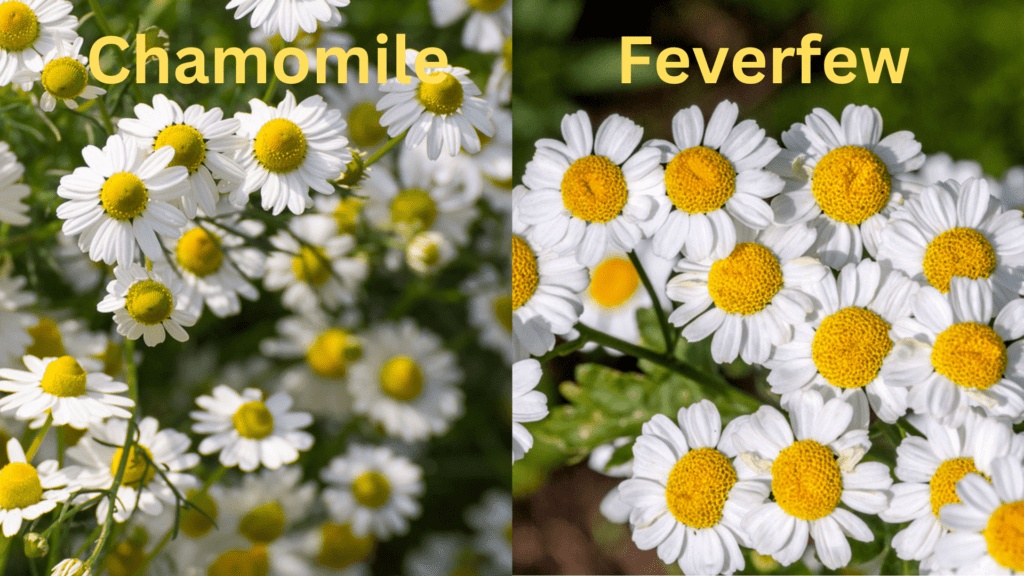Chamomile vs feverfew identification is an important topic for herbal enthusiasts and gardeners alike, as these two plants are often confused due to their similar appearance.
Both chamomile and feverfew have been used for centuries for their medicinal properties, but they serve different purposes and have distinct characteristics.

Understanding the Differences between Chamomile and Feverfew
Chamomile and feverfew are both members of the Asteraceae family, which also includes daisies, sunflowers, and chrysanthemums.
While they share some similarities, there are key differences between the two plants that can help with identification.
| Feature | Chamomile | Feverfew |
| Botanical Name | Matricaria chamomilla (German chamomile) or Chamaemelum nobile (Roman chamomile) | Tanacetum parthenium |
| Flower Appearance | Daisy-like with white petals and a yellow center | Daisy-like with white petals and a yellow center |
| Flower Size | Smaller, about 1-2 cm in diameter | Larger, about 2-3 cm in diameter |
| Leaves | Finely divided, feathery, and light green | Pinnately divided, broader, and dark green |
| Scent | Sweet, apple-like fragrance | Strong, bitter, and slightly citrusy |
Medicinal Properties of Chamomile and Feverfew
Both chamomile and feverfew have been used in traditional medicine for their various health benefits. Their properties and uses differ significantly.
Chamomile

Chamomile is well-known for its calming and anti-inflammatory properties.
It is commonly used as a tea to help with sleep, anxiety, and digestive issues.
Chamomile also has topical uses, such as treating skin irritations and inflammation.
Feverfew

Feverfew, on the other hand, is primarily known for its potential benefits in treating migraines and headaches.
It has also been used to help with arthritis, menstrual pain, and fever.
Feverfew should not be used during pregnancy, as it may cause uterine contractions.
Similarities and Differences between Chamomile and Feverfew
As mentioned earlier, chamomile and feverfew share some similarities due to their shared family, such as their daisy-like flowers.
There are a few key differences that can help with identification:
- Flower size: Chamomile flowers are typically smaller than feverfew flowers.
- Leaves: Chamomile leaves are finely divided and feathery, while feverfew leaves are broader and pinnately divided.
- Scent: Chamomile has a sweet, apple-like fragrance, while feverfew has a strong, bitter, and slightly citrusy scent.
Potential Confusion between Chamomile and Feverfew Plants
Due to their similar appearance, chamomile and feverfew plants can often be confused with one another.
This can be particularly problematic when using these plants for medicinal purposes, as their properties and uses differ significantly.
To avoid confusion, it is essential to become familiar with the distinguishing characteristics of each plant, such as flower size, leaf shape, and scent.
When to Use Chamomile and When to Use Feverfew
Understanding the differences between chamomile and feverfew is essential for using these plants effectively and safely.
In this section, we will discuss when to use chamomile and when to use feverfew for various ailments and purposes.
| Condition or Purpose | Chamomile | Feverfew |
| Sleep Issues | ✔️ | ❌ |
| Anxiety | ✔️ | ❌ |
| Digestive Issues | ✔️ | ❌ |
| Skin Irritations | ✔️ | ❌ |
| Migraines | ❌ | ✔️ |
| Headaches | ❌ | ✔️ |
| Arthritis | ❌ | ✔️ |
| Menstrual Pain | ❌ | ✔️ |
| Fever | ❌ | ✔️ |
Other Plants That Look Like Chamomile
Chamomile and feverfew are not the only plants that can be easily confused due to their similar appearance.
Several other plants also have daisy-like flowers and can be mistaken for chamomile or feverfew.
Some of these plants include:
- Oxeye Daisy (Leucanthemum vulgare): This plant has larger flowers than chamomile and feverfew, with more elongated white petals. The leaves are also broader and have a more distinct toothed appearance.
- Shasta Daisy (Leucanthemum x superbum): Shasta daisies have larger flowers and a more robust growth habit than chamomile and feverfew. The leaves are dark green, lance-shaped, and have a slightly toothed margin.
- False Chamomile (Tripleurospermum inodorum): Also known as scentless chamomile, this plant has a similar appearance to chamomile but lacks the sweet, apple-like fragrance.
Feverfew vs Chamomile: Final Thoughts, Similarities, and Differences
Chamomile and feverfew are two distinct plants with different medicinal properties and uses.
While they share some similarities, such as their daisy-like flowers, there are key differences that can help with identification:
- Flower size: Chamomile flowers are typically smaller than feverfew flowers.
- Leaves: Chamomile leaves are finely divided and feathery, while feverfew leaves are broader and pinnately divided.
- Scent: Chamomile has a sweet, apple-like fragrance, while feverfew has a strong, bitter, and slightly citrusy scent.
By understanding the differences between these plants and learning how to accurately identify them, you can ensure that you are using the correct plant for your intended purpose.
Whether you’re seeking relief from sleep issues, anxiety, or migraines, knowing the differences between chamomile and feverfew is crucial for effective and safe use.
